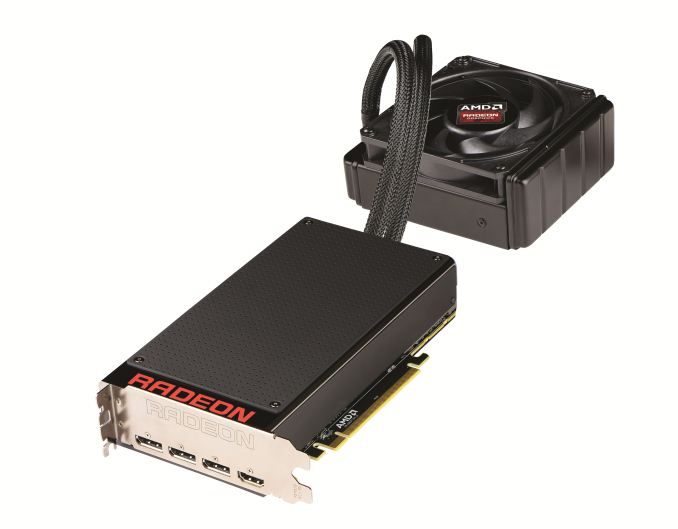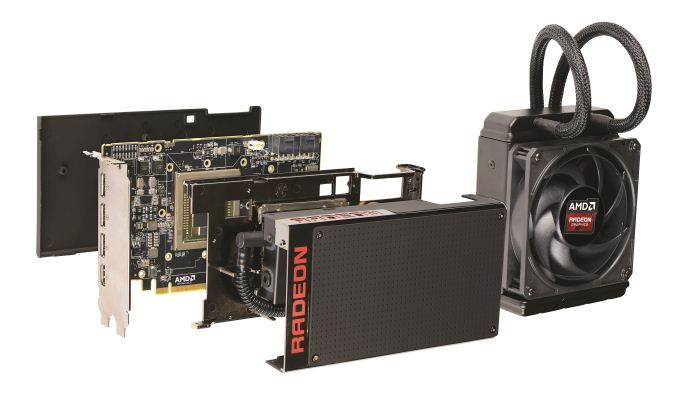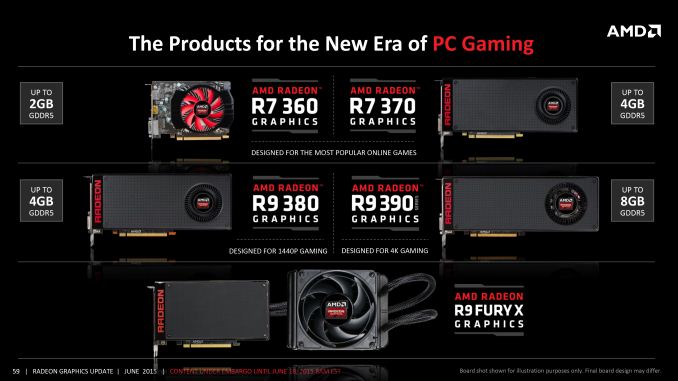AMD Launches Retail Radeon 300 Series: A Prelude To Fury
by Ryan Smith on June 18, 2015 10:35 AM EST- Posted in
- GPUs
- AMD
- Radeon
- Radeon 300

Throughout the last couple of months AMD has been in the process of carefully and deliberately rolling out their latest generation of video cards. In a multi-staged process we have seen AMD engage in a what is best described as a drawn-out teaser and an early technical briefing, announcing their intention to roll out a new high-end video card this quarter, further teasing the public with pictures of the card, and then in the middle of all of that giving the technical press an in-depth briefing on AMD’s key next-generation memory technology, High Bandwidth Memory. While AMD did their best to make sure the details of the cards were kept under wraps – with varying results – AMD definitely wanted to make sure the world would know that their card was coming.
Catching up to the present, earlier this week AMD held their 2015 GPU product showcase, dubbed “The New Era of PC Gaming.” As the latest stage in AMD’s master plan, AMD held a public event in Los Angeles similar to their 2014 GPU product showcase in Hawaii, where the company announced their product lineup ahead of the full launch of the products in question. In the presentation we learned some (but not all) of the details surrounding AMD’s Radeon 300 series, including the numbered products from 360 to 390, and of course the company’s new high-end flagship video card, the Radeon R9 Fury X.
All told the showcase itself was something of a teaser itself – we got prices, but not complete specifications – but we also received confirmation of AMD’s rollout plans. The next stage, coinciding with today’s article, is the formal launch of the numbered members of the Radeon 300 series, which are product refreshes based on existing AMD GPUs, similar to what we saw with the 200 series in 2013. Meanwhile today is also the greater unveiling (but not the launch) of the Fury series, with AMD allowing us to share more details about the new card and its specifications. Following today’s announcements and launches, the Radeon R9 Fury X will be launching in just under a week from now, on June 24th, and then after that the R9 Fury (vanilla) will be launching on July 14th.
| AMD R9 300 Series Specification Comparison | ||||||
| AMD Radeon R9 Fury X | AMD Radeon R9 Fury | AMD Radeon R9 390X | AMD Radeon R9 390 | |||
| Stream Processors | 4096 | (Fewer) | 2816 | 2560 | ||
| Texture Units | 256 | (How much) | 176 | 160 | ||
| ROPs | 64 | (Depnds) | 64 | 64 | ||
| Boost Clock | 1050MHz | (On Yields) | 1050MHz | 1000MHz | ||
| Memory Clock | 1Gbps HBM | (Memory Too) | 5Gbps GDDR5 | 5Gbps GDDR5 | ||
| Memory Bus Width | 4096-bit | 4096-bit | 512-bit | 512-bit | ||
| VRAM | 4GB | 4GB | 8GB | 8GB | ||
| FP64 | 1/16 | 1/16 | 1/8 | 1/8 | ||
| TrueAudio | Y | Y | Y | Y | ||
| Transistor Count | N/A | N/A | 6.2B | 6.2B | ||
| Typical Board Power | 275W | (High) | 275W | 275W | ||
| Manufacturing Process | TSMC 28nm | TSMC 28nm | TSMC 28nm | TSMC 28nm | ||
| Architecture | GCN 1.2 | GCN 1.2 | GCN 1.1 | GCN 1.1 | ||
| GPU | Fiji | Fiji | Hawaii | Hawaii | ||
| Launch Date | 06/24/15 | 07/14/15 | 06/18/15 | 06/18/15 | ||
| Launch Price | $649 | $549 | $429 | $329 | ||
Overall AMD is launching an almost top-to-bottom refresh of its product lineup overnight. Between now and July 14th the company and its partners will introduce cards from $109 to $649, and while there are a few gaps that AMD is almost certainly purposely leaving in place to give them something to announce later this year, overall we’re seeing more or less AMD’s entire hand for 2015 and early 2016 in one go.
As for the subjects at hand today, there are really two stories to talk about. The first is of course the Radeon R9 Fury series, the products that will house AMD’s newest flagship GPU, Fiji. While I won’t butter up Fiji from an architectural standpoint at this time, what Fiji does bring to the table are two very big changes for AMD. The first of these is of course high bandwidth memory, which not only gives AMD more VRAM bandwidth than ever before, but it outright changes how GPUs video cards are constructed. The second big change is that Fiji is just very big. At 596mm2 AMD went right to the reticle limit, putting AMD squarely into the big GPU race.
But before Fury comes the rest of the 300 series. We'll take a look at Fury in due time - while we've been briefed on the subject and have been authorized to discuss it, we want to hold back for when we have the hardware in hand - so our focus for today will be on what's launching today, and that's the Radeon 300 series.
Being released today are five new cards from AMD’s partners, which will form the backbone of the Radeon 300 series from $109 to $429. To our regular readers these parts will be familiar – and to some, perhaps more familiar than they’d like – while for AMD the 300 series represents their 3rd generation of retail 28nm products.













290 Comments
View All Comments
cjs150 - Thursday, June 18, 2015 - link
"And as a side note I forgot, I think the watercooling push on R9 fury models is simply due to the shorter PCB design "I mused about that yesterday as well. I suspect the issue is that the shorter PCB limits the size of fans that would look sensible and as we all know, usually from bitter experience, small fans and GPUs usually result in something that sound like a jet fighter taking off.
I want to see Fury with a custom waterblock for us custom water loopers but having power connections on back of card makes for very clean builds
xthetenth - Thursday, June 18, 2015 - link
On the other hand, Nano. Of course that looks like they went for one big and good fan.bernstein - Thursday, June 18, 2015 - link
could go either way.but only because of the performance boost of HBM. Since it's GCN1.2 fury X's stream processors have essentially the same efficiency as the R9 285.
bottom line: a gtx 980 ti with HBM would be far more efficient.
however since nvidia will only use HBM with pascal, amd has another year to match nvidias efficiency
SantaAna12 - Thursday, June 18, 2015 - link
I will not be judging it this way.I will be looking at the fps Fury can provide in higher resolutions/Mhz displays.
Yojimbo - Thursday, June 18, 2015 - link
I don't think they will beat Maxwell's efficiency but I think between the architecture changes they've made and the efficiency benefits of HBM they will approach it. It looks like with Fiji, AMD may have reduced double precision performance in exchange for die space/efficiency.xthetenth - Thursday, June 18, 2015 - link
Or we could judge things that you buy to make frames quickly on the basis of how fast they make frames in comparison to the money you spend on them, and if we want to save some watts go to the places where saving huge numbers of watts is trivial like lightbulbs.Or are we just going to be entirely about performance/watt, pack the entire desktop segment up and play games on our phones?
Yojimbo - Thursday, June 18, 2015 - link
Saving Watts with your GPU is also trivial.tomc100 - Thursday, June 18, 2015 - link
All of these refresh cards should have been released months ago to compete against Nvidia's GTX 900 series instead of leaving a giant vacuum for Nvidia to go uncontested and fill up market shares. Also, since none of them uses the new HBM then there's no excuse for not releasing them for so long. AMD's marketing strategy is the worst. This is how you go bankrupt and run their ATI division into the ground.Qwertilot - Thursday, June 18, 2015 - link
Fairly well forced to run down their existing 2xx stock first I'd think? They did that at very low prices of course, so probably about as good an effort to compete as this rebadge/refresh.Really need 14nm to come relative soon and a good range there.
Yojimbo - Thursday, June 18, 2015 - link
I think they just didn't have all the technology ready. They've really taken a beating the past 9 months. I am guessing an inventory write-down would have been preferable to the loss of market share they've recently incurred.